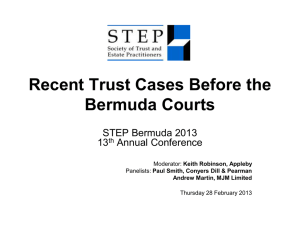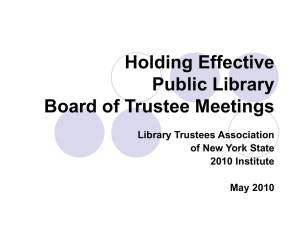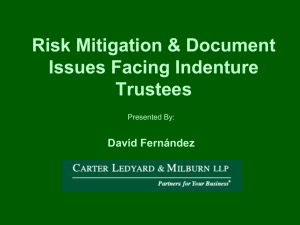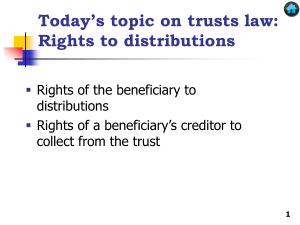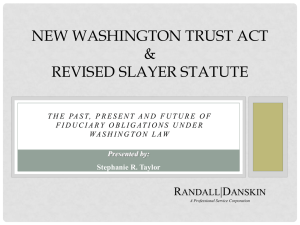Decanting From Irrevocable Trusts – NY`s EPTL
advertisement
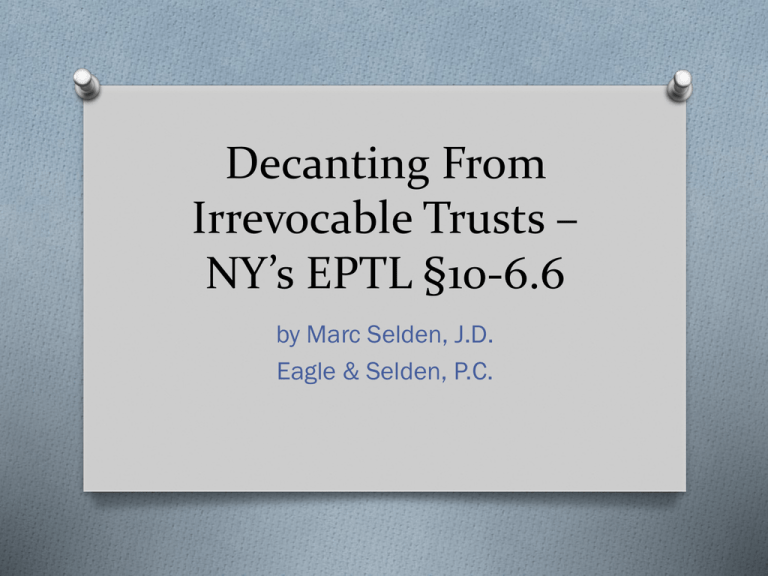
Decanting From Irrevocable Trusts – NY’s EPTL §10-6.6 by Marc Selden, J.D. Eagle & Selden, P.C. EPTL Section 10-6.6 O New York has moved back into the forefront of states with statutes authorizing decanting from irrevocable trusts. O New York was the first state to allow decanting or rewriting or an irrevocable trust when it enacted EPTL 10-6.6 in 1992. O Since then, some states have enacted more flexible statutes. (Delaware, New Hampshire, South Dakota and Tennessee) EPTL Section 10-6.6 O The New York law has been expanded to allow trust decanting under a broader range of circumstances. O This law allows estate planning practitioners to effectuate changes for clients with irrevocable trusts that no longer met the clients goals. O This law allows Trustees to correct mistakes or scrivener errors, to account for changes in the law and circumstances and to take advantage of new estate, gift and GST exemptions. The Original EPTL §10-6.6 O The original EPTL §10-6.6 allowed a trustee to appoint assets from one trust to another only if the trustee had absolute discretion to invade the trust principal for the benefit of one or more proper objects of the exercise of the power. The new law removes this requirement and legislates additional enhancements. New EPTL Section 10-6.6 O The new law permits the trustee to appoint the principal of the original trust to a new trust even if the trustee does not have absolute discretion to invade trust principal. O Allows the new trust to have an expanded term than the original trust, subject to the original trust applicable rule against perpetuities. O Sets forth the operation of the statute if the original trust has multiple beneficiaries. New EPTL Section 10-6.6 O Sets forth the requisite standard for the fiduciary. O Removes the requirement that a trustee of an inter vivos trust file the instrument exercising the power to appoint with the clerk of the Surrogates Court, so long as there has been no Surrogate’s Court Proceeding as to the trust. New EPTL Section 10-6.6 O Makes clear that the exercise of the power to invade the principal is not prohibited if the original trust contains a spendthrift clause or prohibits amendment or revocation of the trust. Invasion of Trust Principal O The new law permits a trustee to appoint principal of an existing irrevocable trust to a new trust as long as the trustee has the power to invade for any purpose. If the trustee does not have unlimited discretion, the new trust must have the same beneficiaries as the invaded trust. The new trust would also have to contain the same provisions as to the trustee’s ability to invade principal. Invasion of Trust Principal O If the new trust’s term has been expanded beyond the original trusts term, the trustee may exercise absolute discretion during the expanded term. O If the trustee has unlimited discretion to invade the principal of the original trust, the new trust can exclude one or more of the current and successor beneficiaries of the original trust. Rule against Perpetuities O An authorized trustee may not exercise a power of appointment in violation of the limitations under 9-1.1, 10-8.1 and 108.2 of the EPTL. O The trust into which the trustee decants may have a longer term than the invaded trust, which may include a term measured by the lifetime of a current trust beneficiary. O Be careful to draft the new trust to comply with the applicable rule against perpetuities period of the invaded trust. Granting a Power of Appointment O If the original trust provided a trustee with unlimited discretion re invasion of trust principal, the new trust can grant a power of appointment (either presently exercisable or exercisable in the future) to one or more of the beneficiaries of the original trust, as long as the beneficiary was eligible to receive outright distributions from the original trust. This is important to GSTT planning. EPTL §10-6.6(b)(1) Fiduciary Duty O An authorized trustee exercising the power to appoint has a fiduciary duty to exercise the power in the best interests of one or more of the proper objects of the exercise of the power and as a prudent person would exercise the power under the prevailing circumstances. O The Trustee may not exercise the power if there is substantial evidence of a contrary intent of the creator and it cannot be established that the creator would be likely to have changed such intention under the circumstances existing at the time of the exercise of the power. O The provisions of the invaded trust alone are not to be viewed as substantial evidence of a contrary intent of the creator unless the invaded trust expressly prohibits the exercise of the power in the manner intended by the authorized trustee. Appointment of Assets O The appointment of all of the assets comprising the principal of the invaded trust to an appointed trust shall include subsequently discovered assets of the invaded trust and undistributed principal of the invaded trust acquired after the appointment to the appointed trust; and O The appointment of part but not all of the assets comprising the principal of the invaded trust to an appointed trust shall not include subsequently discovered assets belonging to the invaded trust and principal paid to or acquired by the invaded trust after the appointment to the appointed trust; such assets remain the assets of the invaded trust. Exercise of Power to Appoint O The exercise of the power to appoint to an appointed trust shall be evidenced by an instructed in writing, signed and dated and acknowledged by the authorized trustee. The exercise of the power shall be effective (30) thirty days after the date of service of the instrument …unless the persons entitled to notice consent in writing to a sooner effective date. Exercise of Power to Appoint O An authorized trustee may exercise the power authorized without the consent of the creator, or of the persons interested in the invaded trust, and without court approval, provided that the authorized trustee may seek court approval for the exercise with notice to all persons interested in the invaded trust. Exercise of Power to Appoint O A copy of the instrument exercising the power and a copy of each of the invaded trust and the appointed trust shall be delivered: O (A) to the creator, if living, of the invaded trust, O (B) to any person having the right, pursuant to the terms of the invaded trust, to remove or replace the authorized trustee exercising the power, and O (C) to any persons interested in the invaded trust and the appointed trust…by registered or certified mail, return receipt requested, or by personal delivery or in any manner directed by the court having jurisdiction over the invaded trust. Exercise of Power to Appoint O The instrument exercising the power shall state whether the appointment is of all the assets comprising the principal of the invaded trust or a part but not all the assets comprising the principal of the invaded trust and if a part, the approximate percentage of the value of principal of the invaded trust that is the subject of the appointment. Exercise of Power to Appoint O Objections to Trustee’s exercise of power to appoint: A person interested in the invaded trust may object to the trustee’s exercise of the power by serving a written notice of objection upon the trustee prior to the effective date of the exercise of the power. The failure to object shall not constitute consent. Exercise of Power to Appoint O A copy of the instrument exercising the power shall be kept with the records of the invaded trust and the original shall be filed in the court having jurisdiction over the invaded trust. O Where a trustee of an inter vivos trust exercises the power and the trust has not been the subject of a proceeding in the surrogate’s court, no filing is required. Limitations of Trustee O A power may be exercised by the Trustee unless expressly prohibited by the terms of the governing instrument, but a general prohibition to amendment or revocation of the invaded trust or a provision that constitutes a spendthrift clause shall not preclude the exercise of a power of appointment. Limitations of Trustee O O O O O O An authorized trustee may not exercise a power authorized to effect any of the following: 1. To reduce, limit or modify any beneficiary’s current right to a mandatory distribution of income or principal, a mandatory annuity or unitrust interest, a right to withdraw a percentage of the value of the trust or a right to withdraw a specified dollar amount, provided that such mandatory right has come into effect with respect to the beneficiary. Notwithstanding the foregoing, the authorized trustee may exercise a power to appoint to a supplemental needs trust that conforms with the provisions of section 7-1.12 of the EPTL; 2. To decrease or indemnify against a trustee’s liability or exonerate a trustee from liability for failure to exercise reasonable care, diligence and prudence; 3. To eliminate a provision granting another person the right to remove or replace the authorized trustee exercising the power unless a court having jurisdiction over the trust specifies otherwise; 4. To make a binding and conclusive fixation of the value of any asset for purposes of distribution, allocation or otherwise; or 5. to jeopardize the deduction or exclusion originally claimed with respect to any contribution to the invaded trust that qualified for the annual exclusion under 2503(b) or the IRC, the marital deduction under 2056(a) or 2523(a) of the IRC, or the charitable deduction under 170(a), 642(c), 2055(a) or 2533(a) of the IRC, the qualification of a transfer as a direct skip under section 2642(c) of the IRC or any other specific tax benefit for which a contribution originally qualified for income, gift, estate, or GSTT purposes under the IRC. Limitations of Trustee O An authorized trustee shall consider the tax implications of the exercise of this power. O An authorized trustee may not exercise a power to change the provisions re determination of compensation of any trustee. Trustee commissions should be determined as they were for the invaded trust. O No trustee shall receive a commission or any other compensation for appointing property pursuant to this EPTL 10-6.6. Applicability to NY Trusts O EPTL 10-6.6 applies to any trust governed by the laws of NY, including a trust whose governing law has been changed to the laws of the State of NY; and O Any trust that has a trustee who is an individual domiciled in NY or a trustee which is an entity having an office in the state, provided that a majority of the trustees select this state as the location for the primary administration of the trust by an instrument in writing, signed and acknowledged by a majority of the trustees. The instrument exercising this selection shall be kept with the records of the invaded trust.

